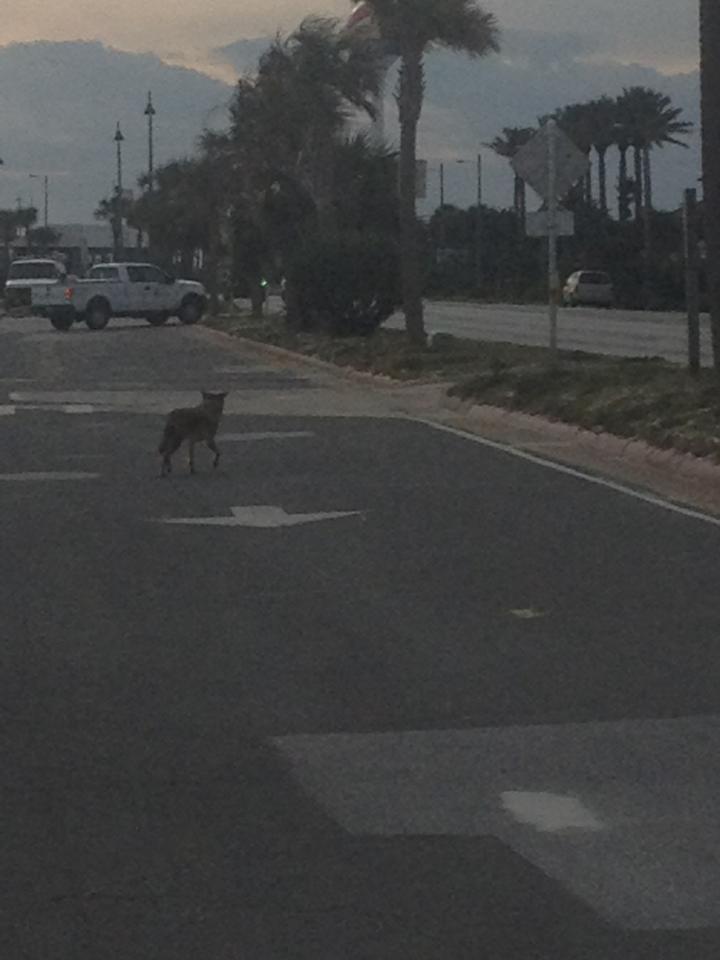
by Rick O'Connor | Apr 14, 2018
In my job, I get many calls about snakes. Most people want to know how to tell a venomous from a nonvenomous one and how to keep them out of the yard. I was recently reading a new book out by Dr. Sean Graham entitled American Snakes and in the chapter on snake defenses, he provided a long litany of local creatures who consumed snakes – some surprised me. Check this out…
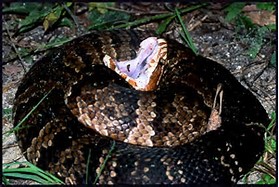
The “cottonmouth” gape of this venomous snakes is a warning. Notice the banded coloration of this individual.
Photo: UF IFAS Wildlife
First, most who do only consume smaller species of snakes – but the list is still surprising. Spiders… spiders were on the list. He specifically called out the black widow – who probably could kill a small snake, but indicated there were others. Scorpions, centipedes, fire ants, carpenter ants, giant water bugs, crayfish, and crabs made the list as well. Some of these may consume snakes only after they are dead – but some can kill small ones.
From the vertebrate world he mentions the larger salamanders (such as the hellbender), and other snakes (such as the short-tailed snake and the coral snake). There are several mammals including shrews, moles, and even the rodents themselves are consumers of snakes! He describes how hoofed mammals (such deer, goat, and horses) do not consume snakes, but can completely destroy one by raising and stopping on them – leaving only small segments remaining. They have found the remains of snakes in the stomachs of all predatory mammals but the snake’s greatest threat are birds… by a long shot. Species from passerines to raptors have been known to kill and consume snakes.
What about venomous snakes – who consumes rattlesnakes and cottonmouths?
There are surprises here as well…
Bullfrogs… bullfrogs basically consume what they can get into their mouths but this includes snakes – and venomous ones as well (though they would be small ones). From the fish world, both the gar and largemouth bass are known to consume venomous snakes.
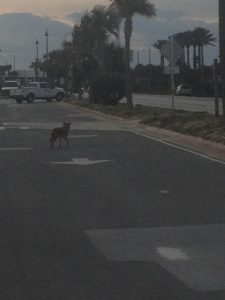
A coyote moving on Pensacola Beach near dawn.
Photo provided by Shelley Johnson.
Opossums are known to consume at least 12 species of snakes, including venomous ones. They also consume ticks, fire ants, and have a very low occurrence of rabies – a cool animal to have around.
Other mammal consumers of venomous snakes include raccoons, otters, fox, bobcats, coyotes, and black bears. It is understood they must take smaller members of the venomous snake population – but a snake control is snake control.
Most wading birds in our marshes consume snakes, including venomous ones, but it is the red-tailed hawk and the great horned owl that are the masters. Red-tailed hawks are known to consume at least 35 species of snakes, including venomous ones, and – unlike other snake predators – are a larger part of their diet, they seek them out. Great Horned Owls consume at least 13 species, and venomous ones are on the menu.
From the reptile world we begin with the alligator, who has little problem consuming large specimens of both the rattlesnake and the cottonmouth. However, many are snakes… yes, snakes eat snakes and some consume venomous ones. Coral snakes, coachwhips, and cottonmouths have been known to consume other snakes. However, it is the Eastern Indigo and the Kingsnakes who actively seek out venomous species. It is known that kingsnakes have a protein in their blood that makes them immune to the viper’s venoms – and it appears the vipers know this and avoid them. It is not known whether the indigo is immune, but it is known they will seek out venomous snakes and consume. Both of these snakes can take relatively large venomous species.
Of these two, it is the Kingsnake who is the “king” – consuming at least 40 species of snakes. However, both the kingsnakes and the indigo are on the declined. The eastern indigo is currently federally listed as endangered – there has not been a verified record of one in the Florida panhandle since 1997. However, there are anecdotal reports and we encourage anyone who has seen one to send us a photograph. There is an active indigo restoration program going on in Alabama and in the Apalachicola River area. These are the largest native snakes in the U.S. (about 8 feet) and, along with the six-foot kingsnakes, are frequently killed. There is evidence that as the eastern kingsnake populations decline copperhead populations increase, and Vis versa. Some areas near Atlanta are currently experiencing a copperhead “boom”. Clearly, we should reconsider killing both the indigo and kingsnakes. We also understand that habitat loss is another cause of their decline, particularly in the case of the indigo.
When looking at this list of snake consumers we see species that cause other problems – alligators, raccoons, coyotes, and bears have all have had their negative issues. But many we just do not like, such as the opossum, really cause us no harm and control snake populations. Everything has its place in the local environment and not one species seeks out humans for the purpose of harming us – this would include snakes. The negative encounters are for other reasons. But for those who have a deep fear, or are currently experiencing high snake numbers, seeing one of the animals on this in the neighborhood could be a relief.
References
Graham, S. 2018. American Snakes. John Hopkins University Press. Baltimore MD. Pp 293.
O’Connor, M. 2018. Personal communication.

by hollyober | Mar 18, 2018
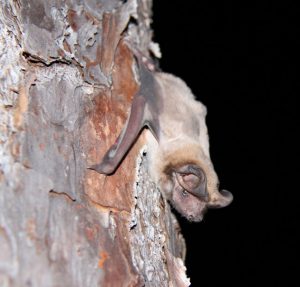
Bats sometimes move into buildings when they can’t find the natural structures they prefer (caves and large trees with cavities).
All 13 species of bats that live in Florida sleep during the day and feed on insects throughout the night. Most of these bats sleep in natural structures such as trees and caves. But when the natural structures these bats prefer are limited or vandalized, the bats may move into buildings.
Bats are a great help to us. Each of them consumes hundreds of insects per night. Bats save growers billions of dollars annually by reducing insect pests. Some of the pests bats feed on include the damaging fall armyworm, cabbage looper, corn earworm, tobacco budworm, hickory shuckworm, and pecan nut casebearer. But both bats and humans are happier when not sharing living spaces!
If you or someone you know has a group of bats living in a building where they are not welcome, you have options. The safe, humane, effective way to coax a colony of bats out of a building permanently is through a process called an ‘exclusion’. A bat exclusion is a process that prevents bats from returning to a building once they have exited at sunset to feed. This is accomplished by installing a temporary one-way door. This one-way door can take many forms, but the most common is a sheet of plastic mesh screening (with small mesh size of 0.125 x 0.125 inches or less) attached at the top and along both sides of the sheet, and open on the bottom. Another option is to install slick tubes (such as clean caulk tubes) to such entry points. These temporary one-way doors should be attached over each one of the suspected entry/exit points bats are using to get in and out of the building.
It is illegal to harm or kill bats in Florida. However, excluding bats from a building is allowed if you follow practices recommended by the Florida Fish and Wildlife Conservation Commission (FWC). According to Florida law, all bat exclusion devices must be left in place for a MINIMUM of 4 consecutive nights with temperatures above 50⁰ F before each entry point can be permanently sealed to prevent bat re-entry. Also, it is unlawful in Florida to attempt to exclude bats from a building between April 15 and August 15, which is bat maternity season. This is when female bats form large colonies and raise young that are unable to fly for their first few weeks of life. If bats were excluded during this time period, young bats (pups) would die indoors.
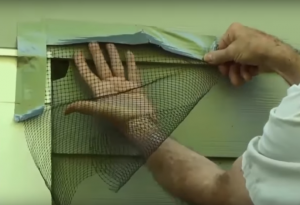
Bats can be coaxed to leave a building by first identifying the bat’s entry points into the building, and then creating a temporary one-way door using plastic screening with fine mesh size over each of these entry points.
The steps for an effective exclusion are as follows:
- Identify the locations where bats are getting in and out of the building. Look for holes or crevices about the width of your thumb, often near the roofline, with brown staining on the exterior of the building and bat scat (guano, about the size of a grain of rice and brown in color) below.
- Fashion and install one-way doors at each suspected bat entry point. This can be done anytime between August 16 and April 14 – it cannot be done when bats have young pups, which is between April 15 and August 15.
- Leave all one-way doors in place for at least 4 consecutive nights with minimum temperatures above 50⁰ F so all bats leave through the doors and cannot re-enter. If any one-way door becomes ineffective during the 4 day period, begin again. You must be absolutely certain all bats have exited so you do not block any inside the building.
- Immediately after removing the one-way doors, permanently seal each hole to prevent bats from getting back inside.
For detailed instructions on how to conduct a bat exclusion, see this video that features interviews with bat biologists from the University of Florida, FWC, and the Florida Bat Conservancy: How to Get Bats out of a Building.
For additional information on Florida’s bats, visit University of Florida’s bat advice or FWC’s bat website.
Remember, if you have a colony of bats roosting indoors that you want to exclude, you must either act within the next few weeks or else wait until the middle of August to coax them out. Bat maternity season in Florida runs from April 15 to August 15, and during this time no one can attempt to exclude bats from a building.
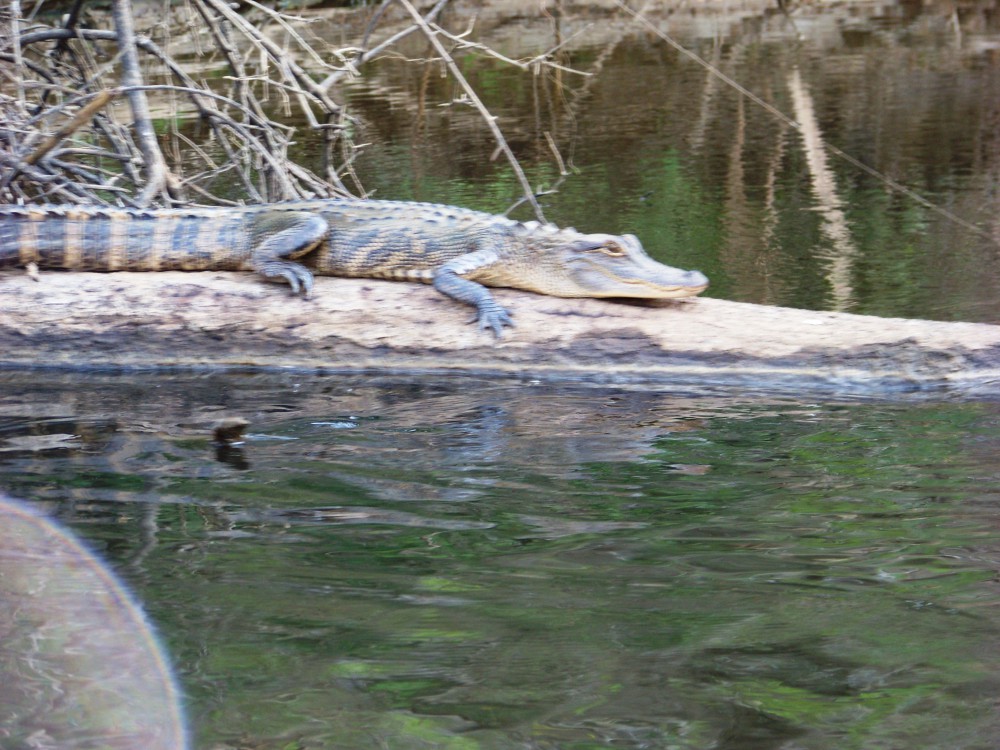
by Rick O'Connor | Sep 15, 2017
I recently saw a photograph of an American Alligator (Alligator mississppiensis) crossing Perdido Key Drive on a heavy rain day. This encounter would surprise some, and unnerve many. The majority of the nuisance wildlife calls I receive are for snakes. I have never received a call for an alligator but no doubt, my colleagues in central and south Florida have. They certainly will with the landfall of Irma. Just as humans relocate for storms, wildlife does as well. High, dry ground is a need for all, and as our friends return to their homes after the storm, they will no doubt encounter creatures in the debris that can be a bit unnerving.

Alligator basking on a shoreline; photo: UF/IFAS Communications
“Nuisance” is in the eye of the beholder. Defined by the Merriam-Webster dictionary as being annoying, unpleasant, or obnoxious, a nuisance species is one we would rather not have in our yard. Snakes are one of those. Most of the people who call about snakes wish them no harm; they just do not want them on their porch or in their pool. Venomous snakes in particular raise anxiety levels, especially when children or pets are around. Though we do not get many calls on alligators, the feeling a homeowner would have if they found one in their driveway would be the same.
There were no calls on the alligator on Perdido Key. Actually, not everyone believed the photo to be legit. I cannot verify it, but I did receive a call earlier this summer when an American alligator was found swimming and basking on a Gulf beach in Navarre and later near Ft. Pickens. Though not as common as they are in central and south Florida, alligators do live here and they are found on our barrier islands. Though encounters with them are rare, how should a homeowner deal with this potential nuisance? When I give a program on snakes I typically go over four points. Let us go over the same with the alligators.
Is it venomous or not?
Obviously, this is not a question here – no crocodilian is venomous. They do have bacteria in their mouths that have caused problems for some who have survived an attack, but there is no venom. However, in south Florida identification is still important because there is more than one crocodilian roaming the landscape. The American Crocodile (Crocodylus acutus) is a native species found in coastal waters of south Florida, the northern reach of its range. The Speckled Caiman (Caiman crocodylus) is an exotic species from Central and South America that is now found in freshwater canals and lakes of southeastern Florida. It is likely that post Irma cleanup will include encounters with these two. However, this is not likely for the panhandle – our winters are too cold.
How do I avoid encounters?
Generally encounters with nuisance wildlife occur for one of two reasons; (a) we have moved into their habitat or (b), they have come to us.
With the population of Florida growing at an ever increasing rate, currently 21 million people and a growth rate of 1.77%, development continues to expand into habitat where these animals have remained out of our sight for some time. As we continue to move into these habitats, encounters with nuisance wildlife will increase. They will be forced to visit our yards and pools. It is no different with bears.
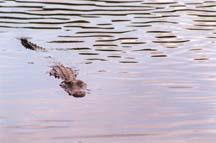
In other cases we, either knowing or unknowingly, provide food and shelter for them. Predators tend to select the easiest prey to kill, the ones that take the less energy. Human development tends to provide habitat for vermin, such as rats, in concentrated areas. This makes hunting for predators, such as snakes, bears, and alligators, much easier – and they will take advantage of this.
With alligators, (a) is more problematic than (b). Alligators have a natural fear of humans and do not typically seek us out looking for easy prey. They seem to prefer to live and hunt away from us. However, feeding alligators changes this and thus, it is a felony to do so in our state. In 2015, the state legislature developed a tiered penalty system for assessing fines and charges. As we continue to develop in areas where alligators live, it will be harder to avoid encountering them.
What do I do if I encounter one?
The general nature of wildlife is reacting to predators, prey, reproduction, and shelter. Alligators are top predators and feed on a variety of species. They are opportunistic hunters, selecting prey they can easily swallow and are relatively easy to catch. Much of these are smaller animals. If the opportunity to make a large kill presents itself, they will – however, they will drown the creature and leave it underwater to soften the carcass so they can swallow.
The method of capture usually involves lying still and waiting for prey to move within range. If encountering an alligator the questions that come to mind are: (1) am I within range? (2) are we near water? – remember they need to submerged large prey. Keep in mind that small children and pets are easier prey and care should taken when in alligator habitat.
Resources provide the following suggestions if an encounter occurs:
- They have a nature fear of humans and will try to retreat. This is true. Provide an avenue of escape for the animal. Do your best not to corner it. Remember it may react to pets and children as prey and could approach.
- If they hiss, they are warning you that you are getting too close and they are feeling threatened. Back away slowly. Sudden movements could be misinterpreted and they may defend themselves by attacking.
- Keep in mind they are fast moving for several yards, so do not think of them as slow and lethargic.
- Females guarding a nest may attack. They will charge to drive you off but typically return to the nest once you have moved to a safe distance (safe in their minds). Alligators build nests of leaf litter above ground in quiet water areas within their range. You may encounter one while hiking along shore. Avoid these nesting areas.
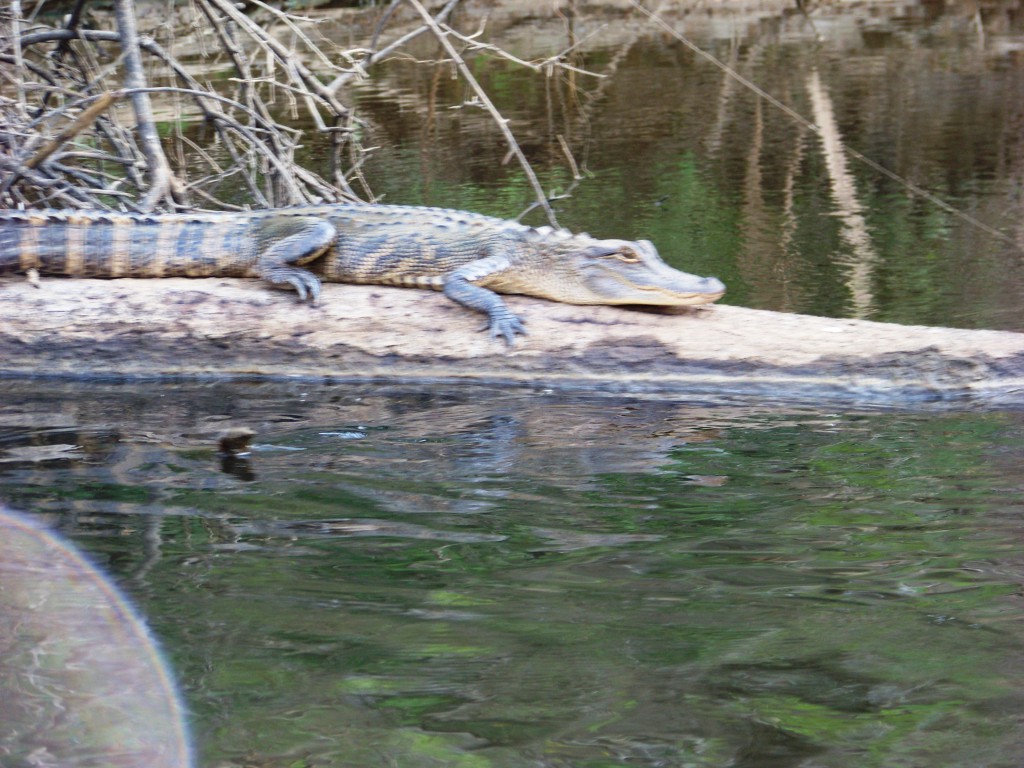
Alligator basking on the Escambia River; photo: Molly O’Connnor
And what if I’m bitten?
This question makes sense if you are talking snakes. With snakes, you are bitten and the snake withdraws. So the question comes up, now what? Not so much with alligators. Though alligators tend to feed on smaller and softer prey, as they increase in age and size, their skull structure adjust to where they can crush turtle shells and mammal bones. Forces have been recorded between 12 and 9452 Newtons, depending on age. When they bite they do not typically withdraw, but rather will drag you into water. Do whatever you can to avoid being dragged into water. Since 1948 there have been 388 alligator attacks, 24 were fatal. That averages to 6 attacks/year statewide and about 1 fatality every 4 years – so it is not very common. But remember, human development is encroaching and we will need to learn to live with them as our ancestors did when the animals were more numerous.
In Florida, an alligator is not considered a nuisance unless it is at least 4 feet in length. If you feel there is a nuisance alligator in your neighborhood you can call.
1-866-FWC-GATOR
References
American Crocodile: Species Profile. National Park Service. https://www.nps.gov/ever/learn/nature/crocodile.htm.
Caiman. 2017. Florida Fish and Wildlife Conservation Commission. http://www.myfwc.com/wildlifehabitats/managed/american-crocodile/caiman/.
Erickson, G.M., A.K. Lappin., A.K. Vilet. 2003. The Ontogeny of Bite-Force Performance in American Alligator (Alligator mississippiensis). Journal of Zoology. Vol 260 (3). Pp. 317-327. https://www.cambridge.org/core/journals/journal-of-zoology/article/the-ontogeny-of-bite-force-performance-in-american-alligator-alligator-mississippiensis/150E92D79C5FAEB821DDBF563888E773. P
Florida Population 2017: Demographics, Maps, and Graphs. 2017. World Population Review. http://worldpopulationreview.com/states/florida-population/.
Merriam-Webster Online Dictionary. https://www.merriam-webster.com/dictionary/nuisance.
Statewide Nuisance Alligator Program. 2017. Florida Fish and Wildlife Conservation Commission. http://myfwc.com/wildlifehabitats/managed/alligator/nuisance/.
Swiman, E., M. Hostetler, S. Webb Miller, M. Main. 2017. Living with Alligators: A Florida Reality. University of Florida Institute of Food and Agricultural Science Extension Electronic Data Information Source (EDIS) publication WEC203.
http://edis.ifas.ufl.edu/pdffiles/UW/UW23000.pdf.
Texas Parks and Wildlife. If You See An Alligator. https://tpwd.texas.gov/huntwild/wild/species/alligator/safety/index.phtml.
Wildlife Feeding Rules and Penalties. 2017. Florida Fish and Wildlife Conservation Commission. http://myfwc.com/news/resources/fact-sheets/feeding-rules-and-penalties/.

by Mark Mauldin | Aug 18, 2017

White-tailed deer, a species that is both highly sought after by sportsmen and an unwanted nuisance to many. Sportsmen modify habitat to attract deer and homeowners can modify habitat to stop attracting deer.
(Photo by Eric Zamora)
As a County Agent, I receive a wide variety of calls from clients relating to wildlife. The majority of these calls are quite positive; clients need help improving wildlife habitat or simply need a creature identified to satisfy their curiosity. However, from time to time, situations develop where wildlife behavior becomes a nuisance to a client. The following are some key concepts that can be applied to stop ongoing nuisance wildlife and/or lessen the likelihood of future nuisance wildlife causing issues around your home. For clarity, nuisance wildlife are specific animals (not an entire species) that are causing a specific problem.
Animals frequent various areas because those areas provide resources necessary to meet the animals’ needs. Animals have three basic needs: 1) Food 2) Water 3) Cover. If an animal(s) is frequenting your property and causing some kind of damage, as to become a nuisance, it is incredibly likely that the animal’s presence and nuisance behavior are related to the animal seeking food, water, or cover. With this concept in mind, there is a four-step process that can be utilized to alleviate the issue.
Step 1: Identify the species of animal responsible for the nuisance behavior. Accurate identification of the species causing the problem is key to developing a successful plan of action for stopping the issue. Do not make assumptions or guesses, use available resources to make a definitive identification. Animals can generally be identified by looking at the type of damage caused (i.e. soil disturbance, tree bark damage, vegetation clipping, garden damage, etc.), signs left by the animal (scat, tracks, etc.), and the time of day/night the damage occurs. Careful observation of these factors should lead to an accurate identification of the nuisance animal.
Step 2: Determine why the animal is frequenting your property. After you have identified the problem animal and familiarized yourself with its normal behaviors you should be able to deduce what the animal finds appealing about your property. In some cases, the damage caused by the animals plainly shows why they are there, other times it might not be as obvious. Remember, they are likely there in search of food, water, or cover.
Step 3: Implement steps to address the situation. After you have determined “what & why” you can formulate an appropriate plan for addressing the issue. Generally, the plan will include steps in one or more of the following categories:
1) Habitat modification – This is generally the most practical approach to dealing with nuisance wildlife. In its simplest form, habitat modification is simply removing or altering whatever environmental factor is attracting the nuisance wildlife. The most common example of habitat modification is the removal of wildlife food sources (i.e. pet food, bird feeders, easily accessible garbage and/or compost).
2) Deterrents – Any measure that restricts access to the resource desired by the nuisance wildlife. These measures can include, physical barriers (fencing, etc.), hazing or scare tactics (eyespot balloons, holographic foil, motion-sensitive sprinklers, noise-makers, dogs), and chemical repellents. Deterrents are generally more expensive than habitat modification and their effectiveness tends to decrease over time.
3) Trapping or killing the nuisance animal – These are only to be considered as last resorts. Even when trapping or killing is the only option, they generally only provide a temporary solution to the problem if the environmental factor drawing the animals is not also addressed. Additionally, many state and federal regulations that dictate when trapping or killing wildlife is permissible.
Step 4: Evaluate your level of success and make necessary adjustments. Observe any changes in wildlife behavior and modify your approach as necessary. Begin with habitat modification; if that is not effective make sure the correct modification(s) was made. If no additional modification can be made look at deterrents. Only if all habitat modification and deterrent options have proven ineffective would you move on to trapping or killing. As you move through this process you may wish to seek professional assistance. Contact your county’s UF/IFAS Extension Office for general advice or FWC for a list of professional nuisance wildlife trappers.
This article was adapted from Overview of How to Stop Damage Caused by Nuisance Wildlife in Your Yard by Holly K. Ober and Arlo Kane. There are links throughout the article to a series of publications by the same authors that explore the various topics in detail.
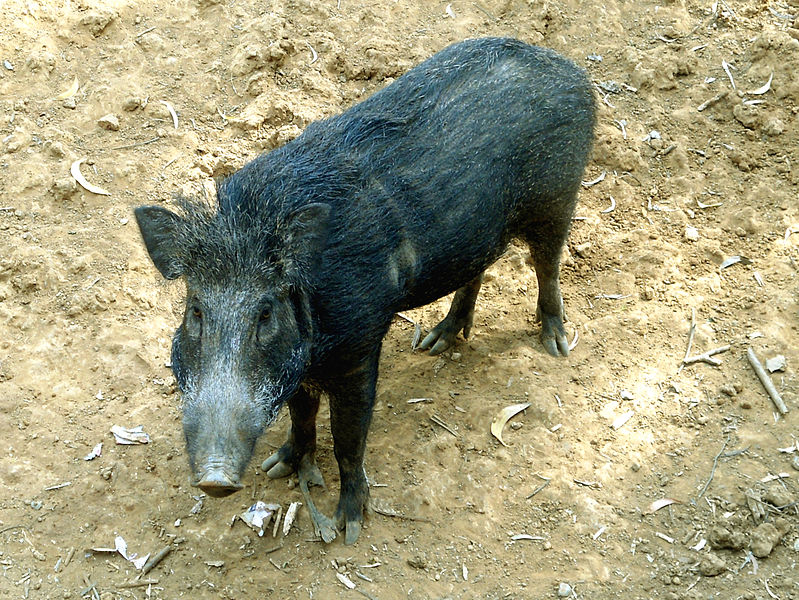
by Jennifer Bearden | Feb 4, 2017
Despite efforts by public and private land managers, feral hog populations continue to rise in many areas in Florida. Feral hogs damage crop fields, lawns, wetlands, and forests. They can negatively impact native species of plants and animals. Their rooting leads to erosion and decreased water quality.
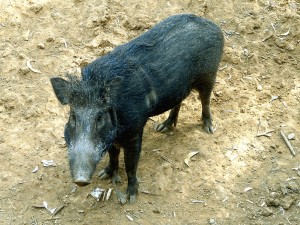
Wild boar Photo Credit: Florida Fish & Wildlife Conservation Commission
There are several options for controlling feral hogs. Choosing the right option depends on the situation.
Options include:
- Hunting with dogs,
- Hunting with guns,
- Box Traps,
- Corral Traps.
Let’s talk about these options.
Hunting with dogs is really not very effective for removing enough hogs to control populations. Dog hunting can move sounders of hogs from areas where damage is occurring for a period of time. This can be helpful when crops need to be protected from hog damage until they can be harvested.
Shooting hogs also is not effective for removing large numbers of hogs. Situations where it is successful include protecting crop fields and for taking hogs that will not go into a trap. Shooting success depends the education level of the hogs and the sophistication of the shooting equipment available. Hogs learn quickly to avoid danger. They learn by watching other hogs who get shot or trapped. Hunting pressure can disrupt hog patterns and make them harder to trap or hunt.
Box traps can be effective at trapping young hogs that are not trap smart. A study conducted by a graduate student, Brian Williams, at Auburn University looked at the efficacy of different trap styles. Young hogs entered box traps and corral traps at similar rates. The study also found that adult females were 120% more likely to enter corral traps than box traps and adult males were more reluctant to enter either trap style but were more likely to enter the corral traps. (Williams et al, 2011)
Corral traps are shown to be most effective for eliminating complete sounders. By eliminating a sounder at once, populations can be reduced. Corral traps are also more economical. In the Auburn study, the trapping cost per pig for box traps was $671.31 and for corral traps was $121.28.
Corral traps are best for capturing whole sounders. Box traps can be effective for capturing young hogs. When trap smart adult females or males are in an area, shooting or hunting with dogs are options. Just remember that hunting pressure often just moves the hog problem onto another property. In order to eliminate hogs from a given area, we must employ several of these strategies. For example, we may be able to trap a sounder in a given area but still have a group of boars that will not go into a trap. In this case, we may set up to shoot them after trapping the rest of the hogs in a corral trap. By using these two techniques, we can drastically reduce the number of hogs in an area.
[youtube https://www.youtube.com/watch?v=FsGJP_HjR60]
For more information about feral hogs, go to http://articles.extension.org/feral_hogs.
Reference: Brian L. Williams, Robert W. Holtfreter, Stephen S. Ditchkoff, James B. Grand Trap Style Influences Wild Pig Behavior and Trapping Success. Source: Journal of Wildlife Management, 75(2):432-436













